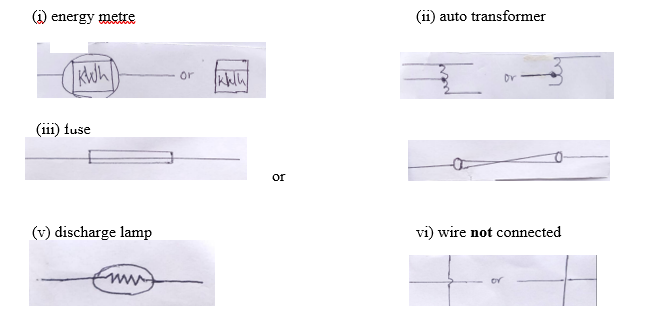Question 2
(a) (i) List four types of electrical joints.
[4 marks]
(ii) Describe how a tee joint is prepared.
[6 marks]
(b) On the table below, list three electrical hand tools used in cleated wiring and state one use of each.
Three tools |
One use |
|
|
|
|
|
|
[6 marks]
(c) State three characteristics of an insulator.
[3 marks]
(d) Draw the British Standard Symbol of each of the following devices:
(i) energy meter;
(ii) auto transformer;
(iii) fuse;
(iv) choice;
(v) discharge lamp;
(vi) wire not connected
Observation
Expected response:
(a) (i) Types of electrical Joints
- scarf - britannia - straight twist /straight through
- married - tee/ breeches
- through - telescope
(ii) Description on how a tee joint is prepared
- bare/strip the straight conductor to about 70mm
- bare the teeing conductor for about 75mm
- clean both bare/stripped conductor
- unstrand the teeing conductor
- roll some strands to the right and same to the left
- leave about 20mm to the right and same to the left
- leave about 20mm of the bared conductor for easy flexibility
- wind the conductors accordingly
(b) Hand tools used in cleated wiring
Tools |
Use |
Hammer |
for driving in nails |
Screwdriver |
for driving in screw nails |
Combination plier |
for joining conductors |
Slide cutter |
for cutting conductors |
Knife |
for stripping/removing insulation |
Raw/Plug tool |
for making holes in walls |
Neon tester |
for testing the presence of current/voltage |
Jimlet |
for making holes in wood |
Spirit level/Plum line |
for levelling |
Saw |
for cutting |
Spincer |
for pulling/extraction |
Measuring tape |
For measuring cables |
(c) Characteristics of an insulator
- high resistance to heat/chemical/moisture
- not ductile
- low mechanical strength
- low temperature coefficient
- low conductivity
- cannot be soldered
- high resistance to current / voltage
(d) British Standard Symbol

